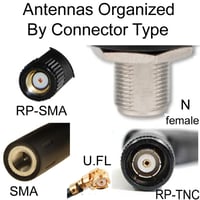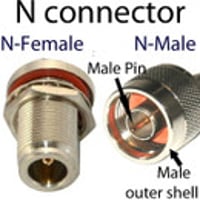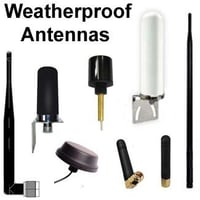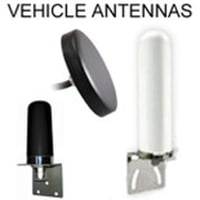Antennas with N-male Connector
Antennas with an N Male Connector:
N-male is the most weatherproof antenna connector type, because it is nickel-plated and is the best connector for outdoor applications.
N male connector antennas a varied group of antennas defined by having a male N connector as their primary point of mechanical and electrical connection. N connectors are medium-sized threaded coaxial connectors that are used in many radio frequency applications that include Wireless Local Area Networking (WLAN), cellular communication, Amateur Radio, and GPS. The male N connector may be directly attached to the base of the antenna or terminate a length of cable that comes from the antenna.
N connectors are also known as N-Type, Navy, or Neill connectors and were created in the 1940s by Paul Neill of Bell Labs. The N-type connector was the first connector capable of handling frequencies above 1 GHz and now is a staple choice of microwave frequency networking. Modern refinements to the design have pushed the upper limit of the N connectors frequency range consistently above 11 GHz.
Physical features of the male N-type connector
The MIL-C-39012 standard specifies the key features of this medium-sized connector. The male N connector consists of a nickel-plated brass body that has a diameter of 0.8 inches (2.3 centimeters). It is a threaded connector with a 5/8-24 United Extra Fine pitch thread that is internalized for screw-coupling with its female (jack) counterpart. It carries an outer grip and in some cases a hex nut to aid in tightening. Within the connector, a silver or gold-plated brass pin forms the inner conducting element. The N-type connector is traditionally air-insulated but may have a Teflon insulator. When properly mated the pin is inserted into the slotted or slotless N female connector receptacle for an electrical connection. A silicone rubber gasket may also be present to aid in forming a weatherproof seal. The N connector can be hand tightened for an adequate connection, or via a wrench if a hex nut is present. The mating torque specified for a proper connection is 7 to 10-inch pounds. It is rated for 500 mating cycles.
Electrical profile of the N male antenna connector
The N connector provides reliable performance in a variety of conditions and has a frequency range of DC to 18 GHz and VSWR of up to 1.3, depending on the connectors manufacturer. Insertion loss and radio frequency leakage (-90 dB at 3 GHz) are both low given its larger size. It is available in 50 and 75 Ohm versions which are not usually interchangeable. As a larger connector than many used for microwave connectivity, its voltage limit is higher than miniature connectors with a maximum voltage of 1500 Volts. This power handling makes it ideal for applications where a lot of power is being put through the antenna.
The male connector is usually attached to the antennas center conductor by soldering. Solder forms a strong and conductive connection between the antenna conductor and the male N connector pin that can withstand repeated connection and disconnection of the antenna. Care should be taken when handling or storing the N connector to protect the connector’s inner pin from dirt, corrosion, and physical impacts.
Why are N male connector antennas important?
This mid-size connector delivers consistent performance at frequencies above 1 GHz making it useful as the primary connector for antennas used in a wide range of networking and broadcast applications including:
- WiFi
- Cellular telecommunication
- Broadcast and Amateur Radio
- Satellite Communication (Satcom)
- Radar
N male connectors are available on a broad range of antenna types and classes meaning, an N male connector antenna should be available for a range of common applications and mounting arrangements.
Key types of N-type male connector antennas include:
[A] Dipole antennas with a male N connector. These omnidirectional antennas are made up of paired conducting elements with a feedline positioned at their mid-point. They are one of the simplest types of antenna but can vary greatly in design and gain. Designs are available for both indoor and outdoor use. Some dipole antennas also have an articulating point which aids in positioning the antennas more accurately. The length of the conductors is usually directly proportional to the wavelength of the frequency at which the antenna becomes resonant. Half-wave and quarter-wave dipole antennas are common.
[B] Co-linear antennas with a male N connector are omnidirectional antennas. They consist of multiple antenna elements arranged within cylindrical fiberglass housing. They are typically mounted at height for good coverage for point to multipoint applications and can be used as both access point and client antennas.
[C] Dual-band N male connector antennas are capable of transmitting and receiving data at two distinct frequencies. Dual-band WiFi antennas operate at both the 2.4 and 5 GHz frequencies that are used by certain 802.11 protocols.
7 key advantages for using an N male connector antenna in your radio frequency setup:
- Antennas with an N male connector are rugged
The N connector is a popular choice of antenna connector for radio applications that will be operating in challenging environments. Its larger diameter means that it forms a strong mechanical connection that readily withstands knocks and impacts. N male connector antennas may be found in harsh environments as they are often used in rapid deployment situations by emergency services and military personnel. Though the larger and heavier connector will take up more space than miniature connectors like SMA or RP-SMA is less prone to mechanical failure due to its sturdy design.
- N male connector antennas deliver reliable performance
The mechanical stability of the N connector means that it can maintain a consistent electrical performance as specified above. They are durable and resilient against thermal shocks, corrosion, and vibration, all features that are essential for business and mission-critical continuity in environments where the antenna is used.
- N male connector antennas are the ideal choice for outdoor antenna installations
Antennas with an N connector are often installed outdoors meaning that they have to be able to withstand the continual environmental exposure that can rapidly degrade an antenna's performance. Their performance is stable over a temperature range of -65°C to +165°C and they have good moisture and corrosion resistance, due to the silicone rubber ring creating a waterproof seal. Some N connector antennas carry the IP67 rating that denotes the antenna as being waterproof. The moisture and corrosion resistance of N connectors also makes them a popular choice of connector for marine antenna installation.
- Male N connector antennas are easy to connect
The size of the N connector means it is easy to handle, especially when aided by the metal grip on the male connector. It is designed to be hand-tightened, though the hex nut on the male can be gripped with a wrench if preferred.
- The threaded connection of N connectors is particularly robust
Threaded radio frequency connectors form particularly stable connections that remain stationary in the presence of impacts, shocks, and vibrations. The threaded connection is particularly advantageous for securing the male N connector antenna to mounting brackets or panels.
- The N connector is rated for a high number of mating cycles
With a male N connector as its termination, you can connect and disconnect an antenna over 500 times without expecting any significant damage or degradation in performance from its specification. One of the key factors that prolong the longevity of this antenna connector is the quality of the inner pin, which is made from high-quality beryllium copper or phosphor bronze and suitably plated to last over multiple mating cycles.
- Nickel-plates brass N connectors are durable
Nickel plating prevents corrosion while maintaining the electrical performance you require from your antenna.
Frequently asked questions
What is the best type of antenna cable for an N connector antenna?
N connectors are designed to be used with both standard coaxial cable and helical coaxial cable using a variant connector. Common coax sizes for N connector antennas include:
- RG 58 (a common pairing)
- RG 8
- RG 214
- RG 316
- RG 393
- RG 225
- RG 141
- RG 174
- RG 179
What are the mounting options for a male N connector antenna?
The larger size and threaded connection of these antennas mean that they can be securely mounted in a variety of arrangements. Male N connector antennas simply screw down onto the complementary female connector that may be attached to a cable, mount, or radio device. Here are some of the common roof, mobile, and base antenna mounting hardware options for a male N connector antenna:
- N female style 4.5" Magnetic Mount
- N connector permanent hole mount
- Trunk lip antenna mounts
- Thick surface mounts
- Luggage rack mounts
- Wall mount and side mounts
- Mast and pipe clamps
When mounting an N male connector antenna care must be taken to ensure that the complementary N female connector is used on cabling and magnetic mounts. N connector adapters can be used to create a connection between the N connector antenna and alternate types of connector (e.g. SMA or TNC).
If mounting an antenna at height, care must be taken to work safely and minimize the risk of falls or electrocution. Use of rubber soles footwear and rubber gloves and long-sleeved clothing when mounting the antenna is advised. Your antenna and cabling conducts electricity and so poses an electrocution risk, especially if there are power lines nearby. Do not attempt antenna installation on wet, windy, or stormy days. Do not use a metal ladder and if any part of your assembly comes into contact with a power line, do not attempt to touch or move it - call your power company immediately for assistance.
How can an outdoor N connector antenna installation be weatherproofed?
Outdoor antenna installations can be protected from moisture and temperature extremes by wrapping the connector and cable in coax tape. Weatherproof sealant tape or strips can be wrapped around the cable and connector to form a moldable seal. When the time comes to remove it, the tape can be cut away with a sharp blade.
N connector lightning arrestors and surge protectors can be used to protect your antenna assembly and radio equipment from surges related to a lightning strike.
In Conclusion
The N connector is a connector of choice for hard-wearing outdoor antenna installations with reliable performance. The larger diameter threaded plug of the N male connector can be securely mounted in many ways, and its rugged handling and corrosion-resistant fabrication will help to prolong the lifespan of the antenna.
LEARN MORE:





